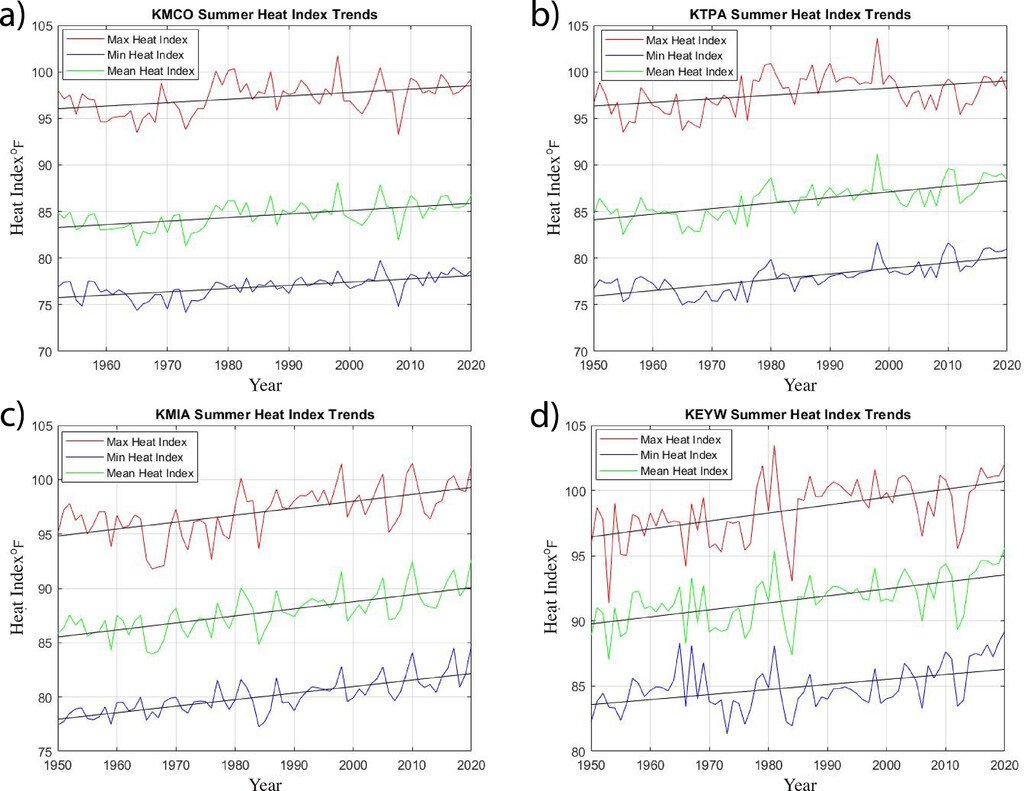Humid Heat Research
Southeast US Observations and Trends
Extreme heat is the deadliest U.S. weather hazard (see NOAA weather-related fatalities chart below). Humid heat stress, defined by Di Napoli et al. (2019) as “high temperatures and moisture levels . . . that can undermine the human body’s ability to maintain its core temperature within the range of optimal physiological performance,” represents the combined impacts of extreme heat and humidity that can be difficult for the human body to tolerate. Although there are many metrics (e.g., heat index) that measure humid heat, many (e.g., heat index) are measured/calculated in the shade and therefore underestimate humid heat impacts on human health. Our humid heat work primarily takes a wet bulb globe temperature (WBGT) approach to identifying observations and trends in heat stress, because WBGT incorporates solar radiation and wind speed.
Recent NOAA-funded work by our research group and North Carolina State University investigated WBGT estimation formulas and trends across the Southeast U.S., using North Carolina ECONet and field measurements of WBGT to validate the estimation formulas. Our work (Wodzicki et al. 2024) published in the Journal of Applied Meteorology and Climatology found that the Liljegren WBGT estimation is the most accurate in the Southeast US (see figure in gallery below). Using this estimation formula, we evaluated trends and extremes in WBGT, using both station-based data in Wodzicki et al. (2024) and the gridded ERA5-Land dataset in Milrad et al. (2025) in the International Journal of Climatology.
Overall, our results (see gallery below) show that the largest WBGT intensity, frequency, and duration trends occur during summer, especially at night and near warm water (e.g., Florida Peninsula, Louisiana Gulf Coast), with exponential increases in the frequency of extreme (90th percentile) WBGT occurring since 2015 at cities such as New Orleans and Tampa. An investigation of WBGT trend drivers found that dewpoint increases are the primary contributor to WBGT increases throughout the region, with temperature playing a secondary role except in the higher elevations of the Appalachians. Our next objective is to establish a regional humid heat/WBGT monitor and rating system and online tool by 2026.
trends, extremes, and drivers of summer WBGT across europe
During my 2023-2024 Fulbright Scholar to Norway term at the University of Bergen, I investigated trends, extremes, and drivers in WBGT across Europe. This work was recently published in the International Journal of Climatology. Results (see gallery below) show that daytime (Daily Max) WBGT increases match or exceed nighttime (Daily Min) WBGT increases across most of Europe, which differs from our Southeast US results. Furthermore, unlike the Southeast US (where dewpoint increases were the primary driver of WBGT increases), temperature increases are the dominant factor in humid heat trends. However, the frequency and duration of extreme humid heat are still increasing fastest near the warm Mediterranean coast, especially at night, once again highlighting the importance of evaporation to nighttime humid heat increases.
Florida trends
Although Florida is known for its warm and humid climate, it is not immune from heat stress impacts on human health, particularly given its older population and prevalence of outdoor (e.g., agriculture, construction) work. In 2024, we published a study in the International Journal of Climatology showing humid heat stress is no longer just a summer problem in Florida. Trends in Autumn WBGT are significantly positive across the state, especially at coastal locations in the Florida Peninsula and at night. These trends are potentially linked to significant increases in Atlantic Ocean and Gulf of Mexico heat content, particularly in September.
See key study results in the figures below
Our 2022 published study in the Journal of Applied Meteorology and Climatology analyzed summer trends in WBGT and heat index at eight Florida cities since 1950. Results (see below) showed that heat stress is increasing significantly, particularly at coastal locations in central and southern Florida and at night. The number of extreme/dangerous heat stress days and nights per summer has also increased across Florida, especially since 2000. Our analysis emphasizes that despite some acclimation, Florida is still susceptible to a serious escalation in extreme heat as the climate warms.


















